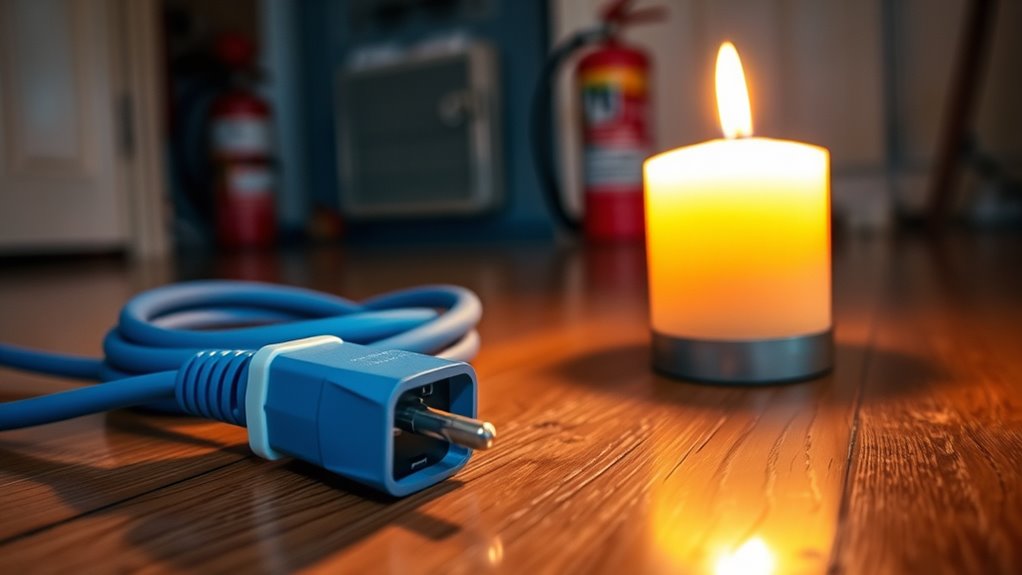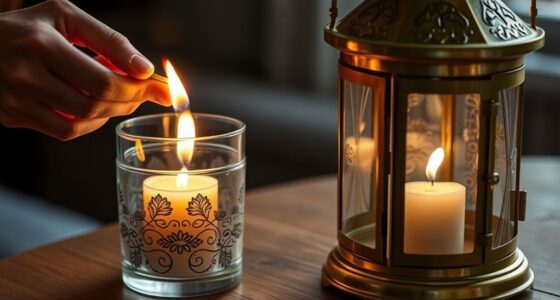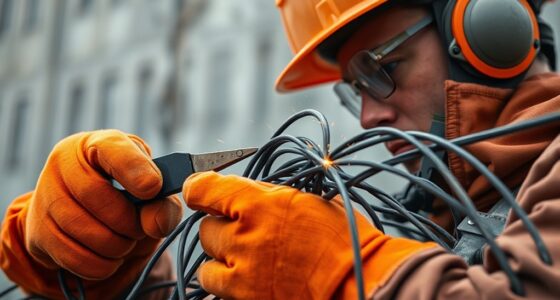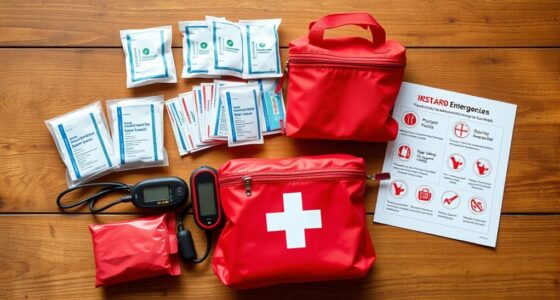To stay safe with extension cords during outages, remember key terms like durability, outlet compatibility, and power ratings. Use the right cord gauge and length for your needs, and avoid overloading or daisy chaining cords. Keep cords away from water, heat, and high-traffic areas, and always inspect for damage before use. Proper management and storage help prevent hazards. Continue exploring these safety basics to ensure you’re fully protected and informed.
Key Takeaways
- Understand extension cord ratings, including gauge and power capacity, to prevent overload during outages.
- Use outdoor-rated cords outdoors and indoor cords indoors to minimize fire and shock risks.
- Avoid overloading circuits by checking connected device wattages and adhering to cord ratings.
- Keep cords fully unrolled during use to prevent overheating and reduce fire hazards.
- Inspect cords regularly for damage and store them properly to maintain safety and longevity.
Common Terms and Definitions in Extension Cord Safety
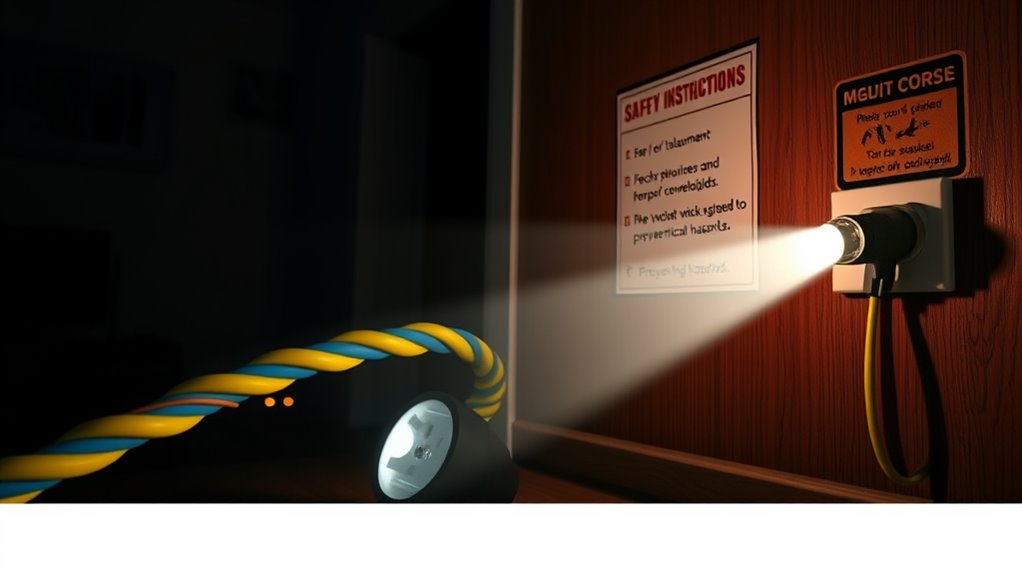
Have you ever wondered what the various terms related to extension cord safety really mean? Understanding key terms can help you choose the right cord for your needs. Extension cord durability refers to how well a cord withstands wear, tearing, and environmental factors over time, guaranteeing it remains safe to use. Outlet compatibility describes whether a cord’s plug fits properly into your outlet without forcing or looseness, reducing risks of sparks or shorts. Knowing these terms helps you select a sturdy, high-quality extension cord that fits your outlets correctly. This not only improves safety but also ensures your devices operate effectively during outages. Being familiar with these basic definitions empowers you to make safer, smarter choices when handling extension cords in any situation. Additionally, understanding power capacity and ratings can prevent overloading and potential fire hazards.
Recognizing Proper Extension Cord Types for Outages
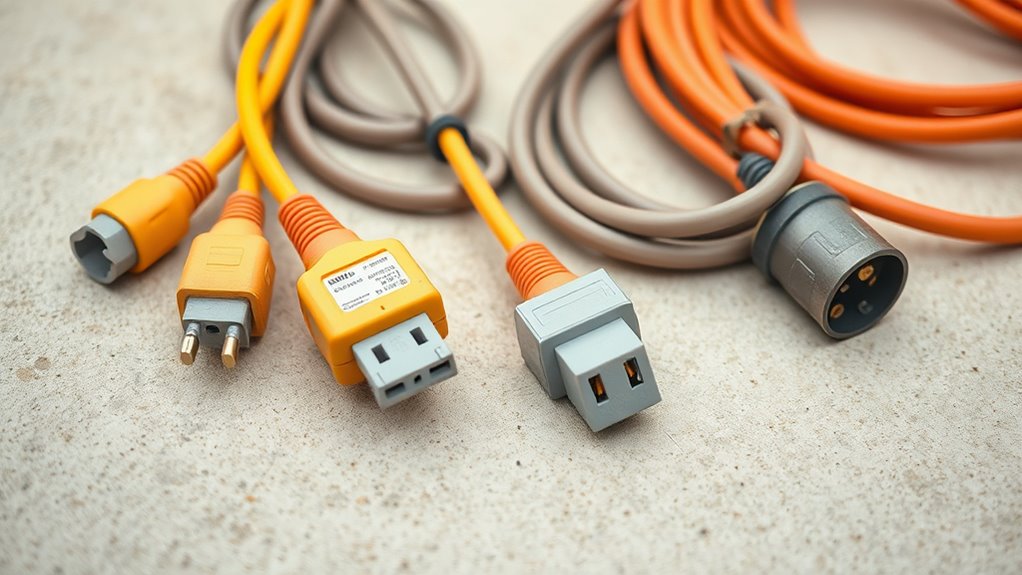
During power outages, choosing the right extension cord is essential to guarantee safety and reliable operation. You need to take into account the cord gauge; a lower gauge number indicates a thicker wire, capable of handling higher current loads without overheating. For powering heavier appliances or tools, opt for a cord with a thicker gauge, such as 14 or 12 gauge. Additionally, select a cord length that suits your needs—longer cords provide flexibility but may reduce power efficiency. Avoid using excessively long cords that could lead to voltage drops, especially during outages when power stability is critical. Properly recognizing the correct extension cord type involves matching the cord gauge to your power requirements and choosing an appropriate length to minimize hazards and ensure safe, consistent performance during outages. It’s also helpful to consult extension cord safety guidelines to further understand best practices.
Key Safety Practices When Using Extension Cords

Using extension cords safely involves following specific practices to prevent accidents and equipment damage. First, avoid overloading circuits by checking the cord’s power rating and not exceeding it. Second, be mindful of cord placement hazards; keep cords away from high-traffic areas, water, and heat sources to prevent tripping or damage. Third, always unroll extension cords fully before use to prevent overheating and reduce fire risk. Additionally, don’t connect multiple extension cords together, as this can overload circuits. Never run cords under rugs or furniture, where heat can build up. By following these key safety practices, you reduce the risk of electrical fires, injuries, and damage during outages. Proper use keeps you safe and your equipment protected.
Electrical Hazards to Watch Out for During Power Outages
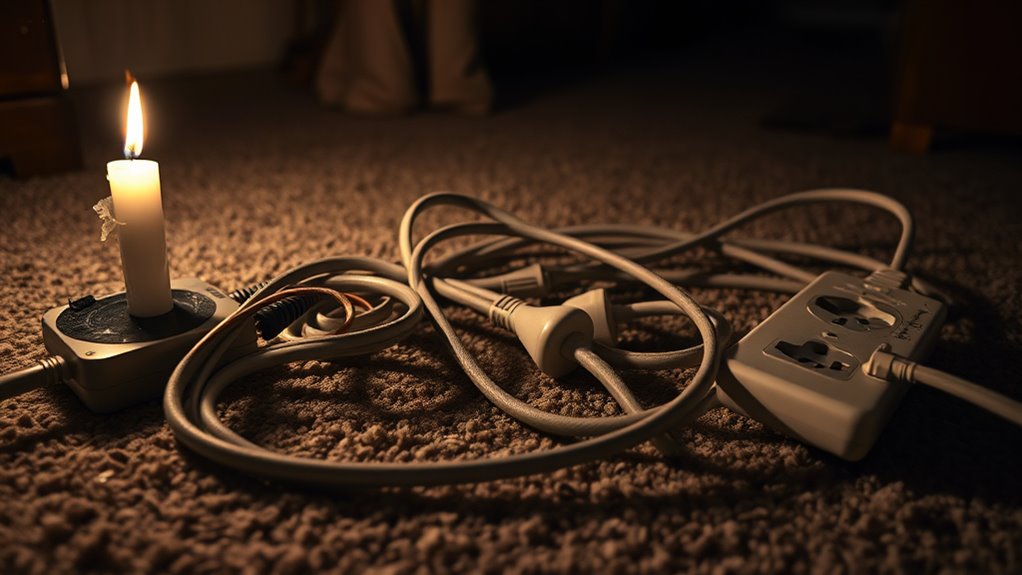
Power outages can create dangerous electrical hazards that often go unnoticed. You need to be aware of risks like electrical shocks, fires, and carbon monoxide poisoning, especially when using portable generators or indoor extension cords. Improperly handling a generator can lead to backfeeding, which endangers utility workers. Using indoor extension cords outside increases the risk of short circuits and fires. Always operate portable generators outdoors in well-ventilated areas, and never connect them directly to your home’s electrical system without a transfer switch. Be cautious with indoor extension cords—avoid overloading them or using damaged cords. Understanding the importance of contrast ratio and proper setup can help prevent some hazards associated with electrical power systems.
Tips for Safe Extension Cord Management and Storage

Proper management and storage of extension cords are vital to maintaining safety and ensuring their longevity. To keep cords in top shape, consider these essential tips:
Proper cord storage and care are key to safety and durability.
- Always inspect cords for damage before use, and perform regular extension cord maintenance to prevent hazards.
- Store cords properly by coiling them loosely to avoid kinks and stresses, using storage solutions like hooks or reels.
- Keep cords away from heat, water, and sharp objects to prevent deterioration and damage.
- Be aware of potential silly mishaps during outdoor use, such as tripping or accidental damage, and plan accordingly.
Frequently Asked Questions
How Do I Choose the Right Extension Cord for Emergency Use?
To choose the right extension cord for emergency use, you should consider the cord length and material durability. Pick a cord long enough to reach your power source comfortably, but avoid excessively long cords that can cause voltage drops. Opt for a durable, heavy-duty material like rubber or reinforced fabric to withstand harsh conditions. Guarantee it’s rated for the wattage of your devices, and check for safety certifications to prevent hazards during outages.
Can Extension Cords Be Used Outdoors During Storms Safely?
You should avoid using extension cords outdoors during storms because weather hazards like rain, wind, and lightning increase the risk of electrical shock or fire. If you must use an extension cord during power outages, choose a heavy-duty, outdoor-rated cord, and guarantee it’s rated for wet conditions. Always unplug cords when storms approach and keep them away from puddles and standing water to stay safe.
What Are Signs an Extension Cord Has Become Unsafe?
Did you know that nearly 3,300 electrical fires annually are caused by damaged cords? You’ll notice an extension cord has become unsafe if it shows visible damage like frayed wires, cracks, or scorch marks. Overheating hazards increase if the cord feels hot or the insulation is worn. Always unplug and replace cords with signs of damage, and never ignore these warning signs to prevent potential fires or electrical shock.
Are There Specific Extension Cords Recommended for Medical Devices?
Yes, you should use medical-grade cords or surge protector cords for medical devices. Medical-grade cords are specifically designed to meet strict safety standards and reduce electrical risks. Surge protector cords help prevent power surges from damaging sensitive equipment. Always choose cords with proper certification, and verify they are in good condition. Using the right cords guarantees safety, reliability, and ideal performance for your medical devices.
How Often Should I Inspect and Replace My Extension Cords?
You should inspect your extension cords at least every three to six months. Look for signs of damage like frayed wires, cracks, or loose connections. Replace cords immediately if you notice any issues to maintain proper cord management and electrical safety. Regular inspections help prevent electrical hazards, ensuring your cords function safely and efficiently, especially during outages or when powering critical devices. Prioritize safety by staying vigilant and replacing damaged cords promptly.
Conclusion
By understanding key terms, choosing the right cords, and following safety practices, you can stay safe during outages. Always stay alert to potential hazards and handle extension cords with care. Remember, a stitch in time saves nine—address issues early to avoid bigger problems later. Keeping safety at the forefront guarantees you won’t be caught off guard when power is out, so don’t let safety fall through the cracks. Stay vigilant and prepared!
